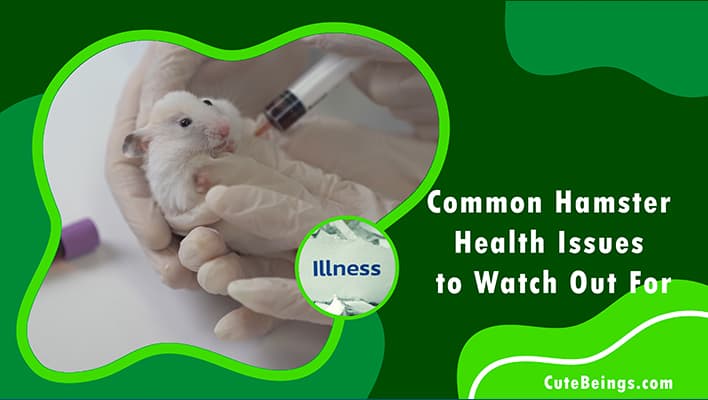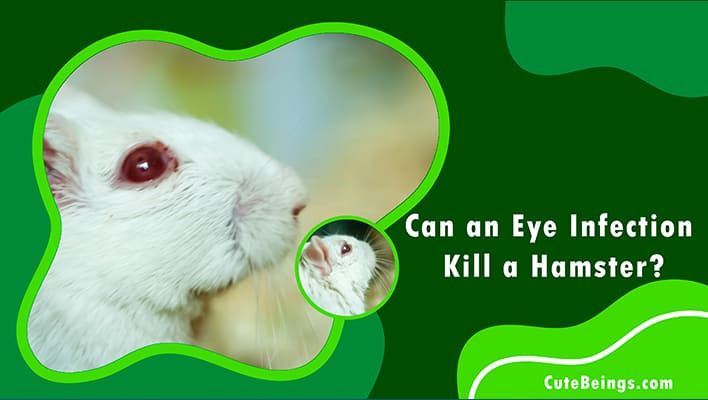There are several common illnesses that can affect hamsters, and it is important to protect your hamster from them. Even small illnesses can be dangerous or fatal for a hamster.
Some of the most hamster common illnesses include:
Hamster Tumors are abnormal growths of tissue that can appear anywhere in the body. They can occur on the skin, bones, organs, and glands, and can sometimes be a symptom of cancer.
An abscess is a pocket of infection that forms at the site of an injury. It is commonly seen as a collection of pus, which is made up of white blood cells and bacteria, around a wound in a hamster. Abscesses are often painful and can cause swelling and redness in the affected area. They can be caused by a variety of factors, including bacteria entering the body through a wound or bite, and can be treated with antibiotics and drainage of the infected pus.
Diarrhea in hamsters can be caused by a variety of factors, including infections with viruses or bacteria such as salmonella. It can also be caused by dietary issues, such as consuming too much water or food that is spoiled or contaminated. Stress, changes in diet or environment, and certain medications can also contribute to diarrhea in hamsters. If your hamster is experiencing diarrhea, it is important to consult a veterinarian for a proper diagnosis and treatment plan.
- Respiratory infections: These are caused by bacteria or viruses and can cause symptoms such as sneezing, discharge from the nose or eyes, and difficulty breathing.
Respiratory infections are a common health problem in hamsters. They are caused by bacteria or viruses that enter the respiratory tract and cause inflammation and infection. Symptoms of respiratory infections in hamsters can include sneezing, coughing, difficulty breathing, and discharge from the nose or eyes. In severe cases, respiratory infections can be life-threatening, so it is important to seek veterinary care if you suspect that your hamster has a respiratory infection. Treatment may include antibiotics, fluids, and supportive care, such as providing a warm, humid environment and making sure your hamster is getting enough fluids and nutrition. Prevention is also important, and you can help reduce your hamster’s risk of respiratory infections by keeping their cage clean and avoiding exposing them to other sick animals or contaminated environments.
- Dental problems: Hamsters have continuously growing teeth, and if their teeth are not worn down properly, they can become overgrown and cause health problems.
Dental problems are a common health concern in hamsters. Their constantly growing teeth can become overgrown and misaligned, which can cause pain and difficulty eating. Overgrown teeth can also cause other health problems, such as abscesses and infections. Some signs of dental problems in hamsters include drooling, loss of appetite, weight loss, and changes in behavior, such as becoming more aggressive or lethargic. To prevent dental problems in your hamster, it is important to provide them with a diet that includes fresh fruits and vegetables and high-quality hamster pellets, which can help keep their teeth trimmed and healthy. You can also offer your hamster chew toys, such as wooden blocks or untreated pieces of natural wood, to help keep their teeth in good condition. If you notice any signs of dental problems in your hamster, it is important to consult a veterinarian for proper diagnosis and treatment.
- Overgrown nails: If a hamster’s nails are not kept trimmed, they can become overgrown and cause discomfort or difficulty walking.
Overgrown nails can be a problem for hamsters, as they can make it difficult for them to move around and can cause discomfort or pain. In severe cases, overgrown nails can cause injury to the feet or toes. To prevent overgrown nails in your hamster, it is important to provide them with a suitable environment that includes a soft substrate, such as aspen shavings or paper-based bedding, for them to burrow and nest in. This can help keep their nails trimmed naturally. You can also offer your hamster a variety of toys and activities, such as climbing structures and tubes, to provide them with opportunities to climb and exercise their claws. If your hamster’s nails do become overgrown, you can trim them with a small nail clipper or file. It is important to be careful and avoid cutting the quick, which is the blood supply to the nail. If you are unsure how to trim your hamster’s nails, it is best to consult a veterinarian for assistance.
- Wet tail: This is a bacterial infection of the digestive system that can cause diarrhea and dehydration. It is often seen in younger hamsters and can be fatal if left untreated.
Wet tail, also known as proliferative ileitis, is a serious and potentially fatal illness in hamsters. It is caused by a bacterial infection of the intestines and is characterized by diarrhea, dehydration, and a loss of appetite. Wet tail is more common in young hamsters, especially those that are stressed or have weakened immune systems. Some signs of wet tail in hamsters include a wet or soiled tail, lethargy, and a hunched posture. If left untreated, wet tail can quickly become life-threatening, so it is important to seek veterinary care if you suspect that your hamster may have this condition. Treatment may include antibiotics, fluids, and supportive care to help your hamster recover. To prevent wet tail in your hamster, it is important to provide them with a clean and stress-free environment, a balanced and nutritious diet, and regular preventative care, such as regular check-ups with a veterinarian.
- Malocclusion: This is a condition where the upper and lower teeth do not align properly, which can cause difficulty eating and other health problems.
It is important to take your hamster to a veterinarian if you notice any signs of illness. Early detection and treatment can help prevent more serious health problems and ensure that your hamster stays healthy and happy.
- Hamster bleeding
It’s important to take your hamster to a veterinarian as soon as possible to determine the cause of the bleeding and get proper treatment. Bleeding from the nose or bottom, or eye bleeding, can be caused by a variety of factors including injury, infection, or a tumor. It’s important to get your hamster checked out by a veterinarian to determine the cause and get the appropriate treatment. In the meantime, try to keep your hamster as calm and stress-free as possible and avoid handling them too much.
It’s generally not a good idea to try to diagnose and treat your hamster’s bleeding yourself based on information you find online. But learn about the bleeding a hamster by reading our articles on the subject. These resources can help you understand the issue and address any concerns or questions you may have.
- Eye Bleeding
- Nose Bleeding
- Bottom Bleeding
- Injuries to the hamster’s leg or other body parts resulting from a fall
If your hamster has injured its leg or has suffered a fall, it is important to take it to a veterinarian as soon as possible. Hamsters can easily break their bones or suffer other serious injuries, and the sooner they receive treatment, the better their chances of recovery. In the meantime, you should try to keep your hamster as comfortable as possible. You can do this by providing a soft bedding material, keeping it in a warm and quiet place, and handling it gently. If you are unsure of how to care for your hamster or if its condition is worsening, it is important to seek medical attention as soon as possible.
- Other
Why Does My Hamster Sleep So Much?
Can hamsters get human illnesses?
Hamsters can potentially get some human illnesses, but they are generally more resistant to diseases than humans. However, it is still possible for hamsters to get sick, and they can also be carriers of certain diseases that they can pass on to humans. It’s important to practice good hygiene when handling any pet, including washing your hands before and after handling your hamster and keeping their living space clean. Additionally, it’s a good idea to have your hamster regularly checked by a veterinarian to ensure they are healthy.
Conclude
Some common signs of illness in hamsters include lethargy, loss of appetite, and changes in behavior or appearance. To protect your hamster from these and other illnesses, it is important to keep its living environment clean and free of excess moisture, provide a healthy diet, and minimize stress. It’s important to keep an eye on your hamster’s health and to consult a veterinarian if you notice any unusual behavior or symptoms. Early detection and treatment can often improve the chances of a successful outcome. As well as , regular check-ups and preventative care can help keep your hamster healthy and prevent the development of serious health problems.

Hello, my name is James and I’ve been caring for tiny pets for over 14 years with a passion. I enjoy passing on my expertise to other individuals in order for them to have the same amount of enjoyment as I do.




